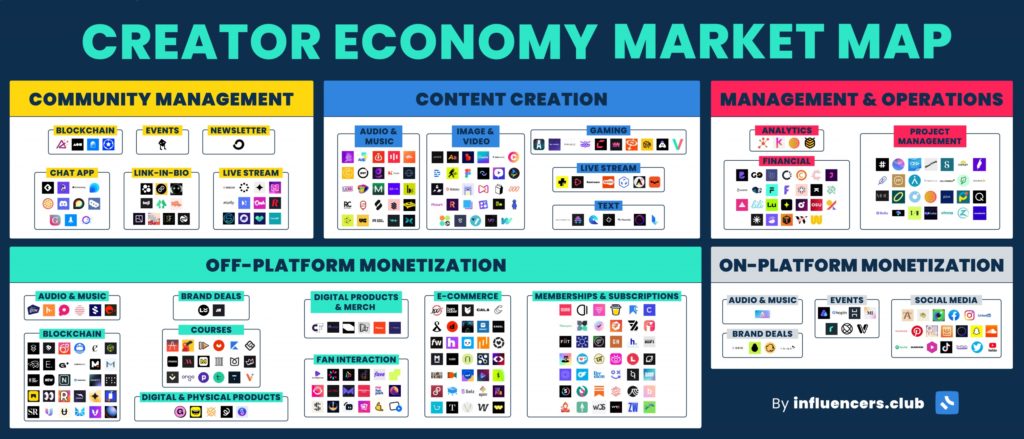
According to a study by UTA, the creator economy presents an $18 billion opportunity for brands.
If you’re active on social media, this is probably not a surprise for you.
After all, there are billions of users across all social media platforms, and millions of these users create content and make money from it.
Either on Instagram, TikTok, YouTube, or any other social network, there are people that are part of the creator economy that can help you achieve your marketing goals.
You just need the right strategy.
But what is the creator economy and how can your brand benefit from it?
To help you understand this and more, we’ve decided to make this complete guide.
And the first thing that you need to know is:
What is the creator economy?
It’s defined as the class of businesses built by over 50 million independent content creators, curators, and community builders including social media influencers, bloggers, and videographers, plus the software and finance tools designed to help them with growth and monetization.
Companies participate in the creator economy by providing the ability to monetize content through paid partnerships and tools to receive payments directly from their audience.

Paid partnerships are basically compensating creators to promote a product through content.
People are able to monetize their content through these methods, among others:
- Paid partnerships with brands
- Tips (Twitch)
- Subscriptions (Patreon)
- Merchandise
As a brand, this term relates to influencer marketing, ambassador marketing, and affiliate marketing, so you may already be familiar with the strategies to grow your brand through the creator economy.
These are the 3 main strategies we will talk about below.
Creator economy statistics
To have a full picture of the creator economy today, let’s look at some facts. The value of the creator economy can be summarized in the following statistics:
- 95% of consumers say they are open to brands participating in the creator economy (UTA)
- 72% of the people who directly support creators are 13-40 years old (UTA)
- Brands are expected to spend $15 billion on Influencer marketing by 2022.
- 223 million people are active on social media in the U.S.
- 63% of consumers trust what influencers have to say about products and services “much more” than what brands say about themselves.
- 76% of consumers say they’re more likely to trust content shared by “normal” people than by brands.
- 83% of consumers say word of mouth has an influence on their purchasing decisions.
- 63% of people report they pay for content from multiple creators (UTA)
So how can you, as a brand, participate in the creator economy?
How to tap into the creator economy
There are many ways a brand can participate in the creator economy, the main one being:
- Influencer marketing
- Ambassador marketing
- Affiliate marketing
These 3 marketing strategies are all about partnering with online content creators for mutual benefits, depending on each strategy.
Let’s take a quick rundown of each of these strategies so you can decide which one you would like to pursue.
Influencer marketing
You’re probably already very familiar with influencer marketing.
This is a pretty straightforward strategy that involves a brand paying a social media creator to create and post content that promotes the brand.
Typically, this type of collaboration is short-term and requires only 1 or 2 pieces of content.
Influencer marketing campaigns are still very effective at driving brand awareness and sales.
There are many cases in which brands have become an overnight success just because an influencer mentioned them.
Influencers have a lot of power for growing brands so it’s a great idea to have influencer campaigns periodically or for product launches, where you need to drive as much awareness as possible.
Here, the most important thing is to choose the right influencers because consumers can see through inauthenticity.
This is something that you shouldn’t overlook because it can result in a negative ROI. Just because someone has followers, it doesn’t mean your promotion will drive sales.
On this point, influencers typically work with many brands at the same time, which can come across as inauthentic.
That’s why the selection process is the most important part.
Ambassador marketing
As authenticity in content became more important for consumers, with 90% saying it’s a key factor when deciding which brand to support, marketers thought of ways to make creator partnerships more authentic.
This is the goal of ambassador marketing.
In this type of strategy, brands partner with creators of all sizes on a long-term basis. Let’s break it down.
An ambassador can be anyone, an influencer, an employee, a student, a customer, etc.
The point of partnering with creators of all sizes is that everyone has influence over their circle.
So maybe a customer doesn’t have millions of followers to promote you, but if they recommend you to their friends, it’s very likely that it will result in a purchase.
67% of people say that they are more likely to purchase a product after a friend or family member shared it on social media.
Now picture a group of ambassadors for your brand creating content consistently and recommending you to their circle.
In addition, long-term partnerships seem much more authentic since you can tell that the creator actually likes the brand.
But how exactly does an ambassador program work?
It’s simple. A brand invites people to become their ambassadors, it can be 1 or even thousands (more is usually better for ambassador marketing).
Then, the brand assigns tasks to its ambassadors, for example:
- Post 2 Instagram posts and 1 TikTok per month
- Refer a friend
- Post an Instagram story in a new store location
- Post a YouTube review
- Submit online reviews
The point is that brands can get creators of all sizes, with different audiences, to create content consistently around the brand.
This content, which can also be called user-generated content (UGC) is super important today for DTC brands and even a necessity.
In exchange, the brand compensates the ambassadors with free products, discounts, cash, or commissions.
Affiliate marketing
Affiliate marketing is a more hands-off approach to ambassador marketing.
Basically, brands launch an affiliate program where anyone can apply.
The approved creators then get the ability to generate unique affiliate links to specific products on the brand’s website.
These links can be used in any piece of online content and it tracks every click it receives and purchases.
For each purchase, the creator gets a commission established by the brand.
As you can see, you are partnering with creators on a long-term basis and generating consistent online content around your brand.
An affiliate program is an amazing tool for brand growth because it gives the creators the creative freedom to promote your products and the ability to earn as much as they want.
And you only pay for results.
The trick here is to find affiliates for your program. You can do this by promoting your program through email, social media, and your website.
Or you can start a brand ambassador program and pay through commissions just by giving your ambassadors the ability to generate affiliate links.
What’s next for the creator economy?
Without a doubt, the creator economy will continue to grow rapidly as people find ways to monetize their online content.
This opens up a massive opportunity for brands to connect with consumers in a way that feels authentic.
In essence, creators are a link between your brand and your target audience.
So you need to include them in your marketing strategy if you’re a DTC brand through one of the methods we talked about above.



